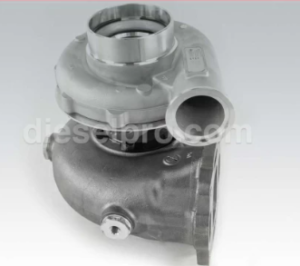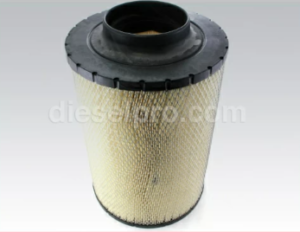Introduction
The air intake and exhaust system is essential for ensuring efficient combustion, reducing emissions, and maintaining engine performance in Cummins QSC 8.3 and QSL 9 engines. This system delivers clean air to the combustion chambers, optimizes turbocharger efficiency, and controls emissions through the Exhaust Gas Recirculation (EGR) system.
A properly maintained air intake and exhaust system prevents power loss, excessive fuel consumption, overheating, and component wear. This guide provides detailed maintenance procedures, troubleshooting steps, and best practices for servicing the air filter, turbocharger, and EGR system.
Parts Catalog for QSC 8.3 Cummins Marine and Industrial Engines
Turbocharger & Related Components for Cummins QSC Engine
Parts Catalog for QSL 9 Cummins Marine and Industrial Engines
Turbocharger & Related Components for Cummins QSL Engine
Air Filter Maintenance and Replacement

The air filter serves as the first line of defense in the intake system, preventing dust, dirt, debris, and contaminantsfrom entering the combustion chambers. A clogged or damaged air filter can lead to poor engine performance, excessive smoke, and increased fuel consumption.
Signs of a Dirty or Failing Air Filter
- Reduced engine power and acceleration
- Increased fuel consumption due to poor air-to-fuel ratio
- Black smoke from the exhaust, indicating incomplete combustion
- Unusual engine noises caused by air intake restriction
- Check engine light or diagnostic trouble codes (DTCs) related to air intake issues
How to Inspect and Clean the Air Filter
Locate the air filter housing. The air filter is usually enclosed in a sealed housing near the intake manifold or turbocharger.
Remove and inspect the air filter. Unclip or unbolt the air filter cover. Carefully remove the air filter and inspect for excessive dirt buildup, tears, or oil contamination.
Clean or replace the filter. If using a disposable paper air filter, replace it with a new one. If using a washable or reusable filter, clean it using compressed air or manufacturer-approved cleaning solutions.
Reinstall the filter and secure the housing. Ensure the filter is seated properly before securing the housing to prevent unfiltered air from entering the system.
Recommended Air Filter Replacement Intervals
Every 500 hours for normal operating conditions.
Every 250 hours for harsh environments such as construction sites, dusty roads, or marine applications.
Inspect and clean the air filter more frequently in off-road or high-dust conditions.
Turbocharger Inspection and Servicing

The turbocharger plays a crucial role in boosting engine power, improving fuel efficiency, and reducing emissions. It uses exhaust gases to spin a turbine, which forces more air into the engine cylinders for better combustion.
Signs of a Failing Turbocharger
- Loss of power or slow acceleration
- Excessive black or blue smoke from the exhaust
- Whining or grinding noises from the turbocharger
- Oil leaks around the turbo housing
- High exhaust temperatures or overheating issues
How to Inspect and Maintain the Turbocharger
Remove the intake piping and visually inspect the turbocharger impeller for dirt buildup, carbon deposits, or excessive wear.
Check for excessive shaft play by gently moving the impeller blades side to side. A small amount of movement is normal, but excessive play indicates bearing wear.
Ensure all oil supply and drain lines are free of clogs or leaks. A lack of proper lubrication can cause turbo failure.
Remove carbon buildup from the turbocharger housing using a turbo-safe cleaner or high-temperature solvent.
Inspect the wastegate and actuator for smooth operation. A stuck wastegate can cause overboost or underboost conditions.
Replace or rebuild the turbocharger if there is excessive wear on the impeller blades, severe oil leaks, or damaged bearings.
Exhaust Gas Recirculation (EGR) System Overview
The EGR system is designed to reduce nitrogen oxide (NOx) emissions by recirculating a portion of the exhaust gases back into the intake manifold. This process lowers combustion temperatures and reduces harmful emissions.
Common EGR System Issues
- Carbon buildup in the EGR valve, leading to restricted airflow
- Sticking or malfunctioning EGR valve, causing power loss or rough idling
- Excessive soot in the intake manifold, leading to reduced engine efficiency
- EGR cooler failure, resulting in coolant leaks or overheating
How to Inspect and Maintain the EGR System
Remove and inspect the EGR valve for carbon buildup. Use an EGR-safe cleaner to remove deposits and ensure smooth operation.
Check EGR piping and intake passages for excessive soot accumulation. Clean with a diesel-rated intake cleaner if necessary.
Ensure the EGR cooler is not leaking coolant into the intake system. A failed EGR cooler can cause white smoke from the exhaust and coolant loss.
If the EGR valve is sticking or not responding properly, consider replacing it with a Cummins-approved replacementto restore proper engine operation.
Preventative Maintenance for the Air Intake and Exhaust System

Inspect the air filter, turbocharger, and EGR system regularly to prevent airflow restrictions and power loss.
Clean or replace the air filter at recommended intervals to ensure proper combustion efficiency.
Monitor turbocharger performance and address issues such as boost pressure loss, oil leaks, or abnormal noises.
Keep the EGR system clean to prevent clogging, excessive soot buildup, and performance degradation.
Ensure exhaust piping, manifolds, and gaskets are free from cracks and leaks to maintain proper engine efficiency.
Conclusion
Maintaining the air intake and exhaust system is essential for fuel efficiency, power output, and emissions compliance in Cummins QSC 8.3 and QSL 9 engines. Regular inspections, timely air filter replacements, turbocharger maintenance, and EGR system servicing will ensure reliable engine performance and longevity.
For OEM-quality aftermarket parts, filters, turbochargers, and EGR components, visit Diesel Pro Power for expert solutions tailored to Cummins engines.
Parts Catalog for QSC 8.3 Cummins Marine and Industrial Engines
Turbocharger & Related Components for Cummins QSC Engine
Parts Catalog for QSL 9 Cummins Marine and Industrial Engines
Turbocharger & Related Components for Cummins QSL Engine



 Free US Calls: 1-888-433-4735
Free US Calls: 1-888-433-4735 International: 305-545-5588
International: 305-545-5588